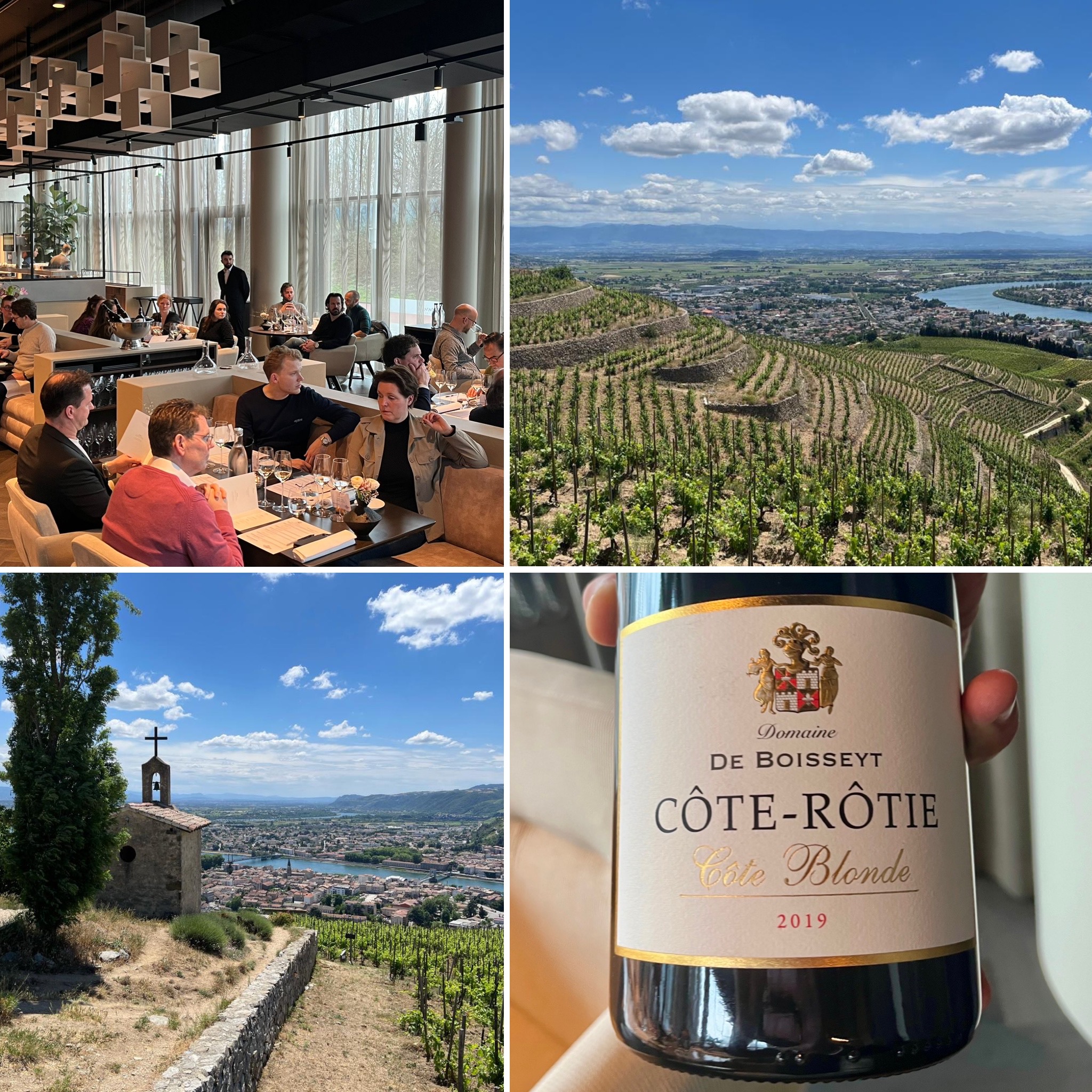Exploring the Northern Rhône with Domaine De Boisseyt.
When classical wine regions are subject of conversation, the French Rhône Valley cannot remain unmentioned. Rhône Wines are inseparable part of classic wine lists and wine cellars without these world-famous wines may be seen as incomplete. Later this year our Hermen will descent to the Mediterranean Southern Rhône by visiting its prestigious wineries. In this article he climbs the steep slopes of the cooler Northern Rhône. Although that does not take him effort: he meets Romain Decelle of Domaine De Boisseyt in the comfortable atmosphere of brand-new Amsterdam Restaurant Showw.
Situation of the Rhône Valley
The French part of the Rhône River runs from the Swiss border to the city of Lyon, from where it bends southwards into the Mediterranean Sea. After Lyon, the river flows through a valley not surprising called the Rhône Valley. It is nestled between the Massif Central in the west and the Alps in the east. In viticultural perspective the Rhône Valley can be divided into two sub regions: the Northern Rhône and the Southern Rhône. The Northern Rhône starts north at the city of Vienne and ends south at the city of Valence. The Northern Rhône valley is narrow and steep. South of Valence the valley widens up into the wide and flat landscape of the Southern Rhône, ultimately ending into the Mediterranean.
Main Characters of the Northern Rhône
Viticulture in the Rhône Valley has been around since timing immemorial. In fact, it is France’s oldest wine region. Celts and Gaul’s already grew wine grapes in the Rhône Valley. Greeks and Romans developed it to fruition and the Roman church lifted it to heavenly hights by transferring a papal residence to the city of Avignon. Where the Southern Rhône is renowned for its warming ripely Mediterranean assemblage wines, the Northern Rhône is marked by its lean single varietal wines from steep granitic slopes. In terms of quantity, the Northern Rhône cannot compete its Southern equivalent. In terms quality however, the Northern Rhône stands its ground.
From a climatological perspective the Northern Rhône can be identified as moderate and continental. Temperatures are noticeable lower than in the Southern Rhône. Vineyards are found on steep hills amongst the river, mostly on the right bank. Please mark the Rhône is floating from north to south, so on the map the right bank is located left. Hermitage and Crozes-Hermitage are situated on the left bank, the other crus on the right bank. The best vineyards are located on steep southern oriented slopes, not seldom in side-valleys where vines are protected against the destructive power of the strong cold northern wind called Mistral.

The profile of Northern Rhône wines is significantly determined by its soil composition. The following main soil types can be found:
- Granite soils: granite is formed by volcanic activities of the Massif Central and provide mineral rich and long shelf-life wines. These soils can be found in Côte Rôtie, Condrieu and Hermitage.
- Sandy and clayey soils rich in silicium: silicium is formed by the decomposition of granite. Sandy soils provide delicate light wines. Clay provides more structured wines. These soils can be found in Hermitage and some spots in Crozes-Hermitage and Saint-Joseph.
- Limestone: limestone provides fresh and aromatic wines. Can be found in some spots in Hermitage.
Where a multitude of grape varietals are used in the Southern Rhône, in the Northern Rhône it is all about Syrah for the reds and Marsanne, Roussanne and Viognier for the whites. Northern Rhône Syrah is deeply coloured, providing moderate to high structured red wines with flavours of black fruit, violet and pepper. Viognier produces voluptuous perfumed white wines, low in acidity and high in alcohol, showing flavours of blossom, peach and apricot. Single variety wines may be found, but Marsanne and Roussanne mostly are found in blends, in which Marsanne provides richness and weight and Roussanne freshness and aromatic fruits.
Domaine De Boisseyt
Domaine De Boisseyt is based in Chavanay, the northernmost village of AOC Saint Joseph. The winery is located on the RN86 from Condrieu to Hermitage and has a long record. In fact, it is one of the oldest wineries in the Northern Rhône. It was founded in 1797, but historical documents refer to viticultural activities in 1343 already. Domaine De Boisseyt cultivates 11 hectares of vineyards in Saint-Joseph, Condrieu, Côte-Rôtie and Hermitage. After Agnés en Didier Chol run the winery for almost 30 years, they passed the baton in 2017 to the French winemaking family Decelle. The domain is bought by Oliver Decelle and is managed by his son Romain Decelle.
Romain Decelle appears to be the type of guy preferring vineyards above high-class restaurants. His wiry body is nestled in a woollen pullover and his grey hair is tied in a bun. His intriguing steel blue eyes seems slightly timid, but his story is noticeable pure and honest. He features deep knowledge of geology and viticulture. His driving force seems to be the health of his vines. Since the takeover the vineyards of Domaine de Boisseyt are cultivated organically.
Romain takes us to the steep terraced vineyards of the Northern Rhône. We let ourselves be caried away by the mighty Rhône River, along its best crus. From north to south, we come across Côte-Rôtie, Condrieu, Château Grillet, Saint-Joseph, Crozes-Hermitage, Hermitage, Cornas and Saint-Péray. We make a stopover in Côte-Rôtie, Condrieu, Saint-Joseph and Hermitage. Enjoy your trip and bon voyage!
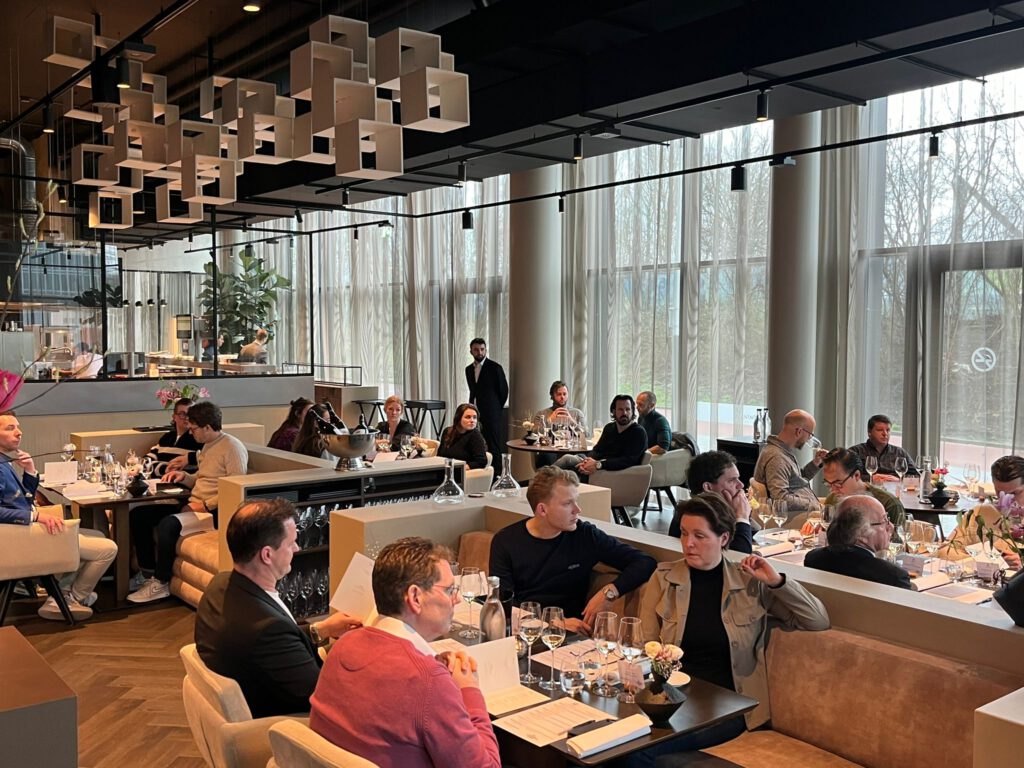
IGP Collines Rhodaniennes
Our journey starts just outside the borders of the Northern Rhône Appellation d’Origine Contrôlées (‘AOC’). Wines that do not fit into the general Côtes du Rhône AOC or one of cru AOC’s, can be classified as – or voluntary declassified to – Indication Géographique Protégée (‘IGP’) Collines Rhodaniennes. Collines Rhodaniennes applies to the whole Rhône, but mainly is used for vineyards around Côte Rôtie, Hermitage and Condrieu.
We taste two Collines Rhodaniennes by Domaine De Boisseyt: Viognier En Amont 2022 and Marsanne En Aval 2022.
Domaine De Boisseyt – Viognier En Amont 2022
The grapes for this wine are sourced from a small northernly exposed vineyard in Chavanay and some plots in Condrieu. Alcoholic fermentation finds place spontaneously in large barrels. The wine ages for about 8 months in large casks. The wine shows itself with expressive aromas of ripe fruits like white and yellow peach and flowery hints. The palate gives a nice balance between ripe fruits and great freshness. The aftertaste leaves clean impressions of lean citrus- and stone fruits.
We award this wine with a 91-point DWA score.
Domaine De Boisseyt – Marsanne En Aval 2022
The Marsanne grapes for this wine are sourced from the village of Saint-Donat in Crozes-Hermitage. The soil consists of sandy and clayey limestone. Vinification is focused on preservation of freshness. The wine offers a bouquet filled with clean stone- and tree fruits, accompanied by a floral and herbal touch. The attack is round and smooth, dominated by beforementioned flavours. The wine shows good weight and pressure and excellent acids prevent from opulence. Marsanne En Aval by Domaine De Boisseyt is a pleasurable balanced wine providing roundness, refreshment and an exciting nutty bite.
We award this wine with a 91-point DWA score.
The Iconic Slope: Côte-Rôtie
Our first stop is Côte-Rôtie. This extremely steep southeast facing slope cannot be missed. The perfect exposition of the slope in relation to the sun, has earned it the name Côte-Rôtie, meaning as much as ‘roasted slope’. The top-notch Syrah based wines may be blended with up to 20% of Viognier, providing stabilisation of the Syrah grapes and stimulating aromatic intensity. A high demand has resulted in an enlargement of the appellation the past years. The original vineyards however are centred on two slopes above the town of Ampuis: Côte Blonde and Côte Brune. The soils of Côte Blonde consist of granite, with soft topsoils. Cote Brune has more schist and iron rich clay soils. Compared to Côte Brune, Côte Blonde wines are more charming and earlier developing.
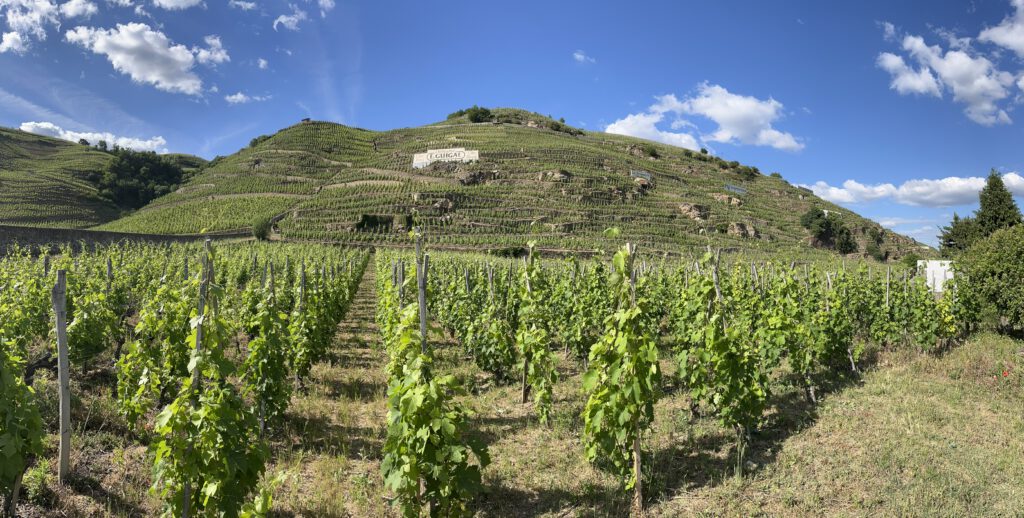
Domaine De Boisseyt – Côte-Rôtie Côte Blonde 2019 (magnum)
The grapes for the Côte-Rôtie Côte Blonde from Domaine De Boisseyt are sourced from a small old parcel in Côte Blonde, composed out of 10 steep terraces. The soil consists of mica schist. The wine is made from 95% Serine and 5% Viognier. Serine is an old Syrah clone, but it is also seen as a separate variety. According to Romain Decelle Serine produces floral and concentrated wines. The wine is fermented in large casks, partly whole bunch. Aging finds place for more than 20 months in barriques, partly new.
The pure and distinguished bouquet shows beautiful dark and red fruits along with floral notes, graphite, smoke and a touch of wood. The palate is simultaneously dense and weightless. Flavours of floating black fruits are accompanied by floral and peppery impressions. The soul of this great Côte-Rôtie is dominated by a graphitelike mineral core. Complexity goes hand in hand with grace and elegance with a long-lasting aftertaste. The youthful wine is remarkable approachable now, but for sure will improve with time. Outstanding wine.
We award this wine with a 95-point DWA score.

Condrieu, the Capital of Viognier
Still enjoying the long aftertaste of the Cote-Rôtie, we already arrive in Condrieu. Condrieu has built up an established reputation for prestigious Viognier based wines. The appellation stretches from the villages of Condrieu in the north to Chavanay in the south. Wines from the village of Chavanay may be declared as Saint-Joseph AOC and as Condrieu AOC. Due to the higher amount of granite in Chavanay, it is said Condrieu wines from Chavanay are more ‘mineral’ in style compared to wines from the vineyards of Condrieu itself.
We taste a Chavanay Condrieu by Domaine De Boisseyt from a steep vineyard called ‘Les Corbonnes’.
Domaine De Boisseyt – Condrieu Les Corbonnes 2022 (magnum)
The old Viognier vines benefit a warm and sheltered microclimate, growing on a decomposed granite soil. Alcoholic fermentation of the handpicked grapes finds place in 12hl casks, followed by 9 months of maturation without racking. The bouquet of Les Corbonnes strikes us as a classical Condrieu. It is both lush and delicate, showing beautiful ripe fruits combined with herbal and floral nuances. The wine catches our attention by its wonderful balance and complexity. It is simultaneously showing richness, breadth, length and depth, all worn by incredible clean acids. The lush fruits are kept in line by a mineral core and an elegant freshness. The long-lasting aftertaste is leaving a clean impression. Outstanding wine.
We award this wine with a 94-point DWA score.
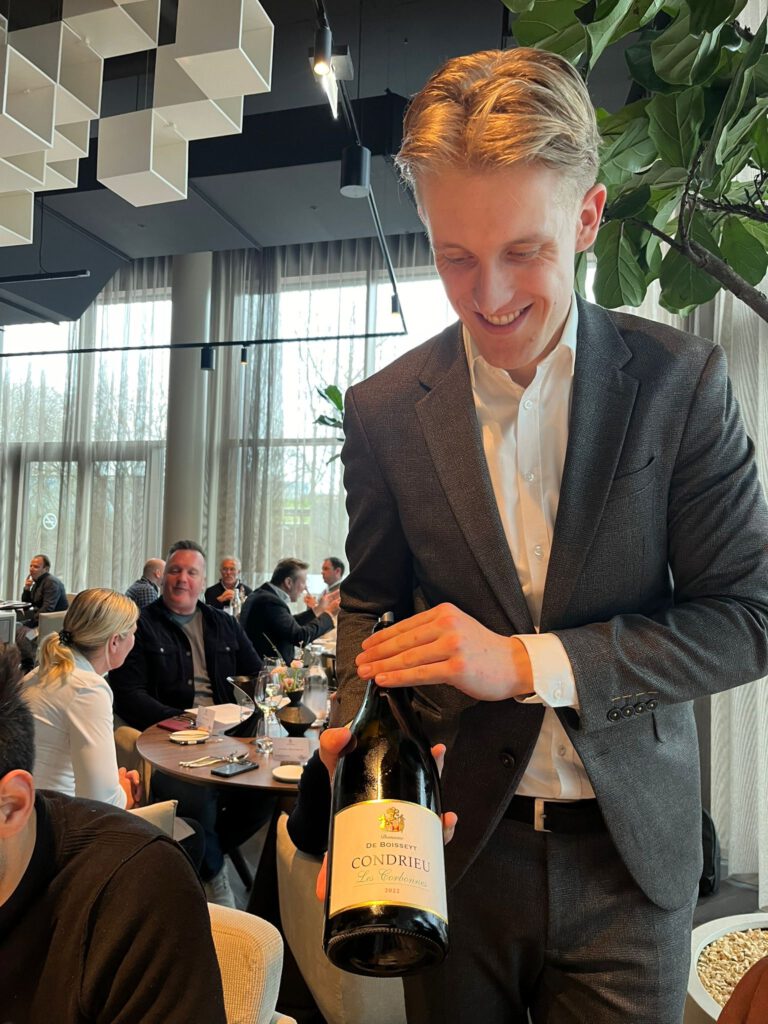
Saint-Joseph, where Syrah thrives
The boundaries of Saint-Joseph AOC once were limited to steep granitic hills in six villages – of which Chavanay was one. Due to expansions in 1969 and 2017 nowadays Saint-Joseph is the largest Northern Rhône appellation. The appellation for red and white wines stretches out from Condrieu in the north to Saint-Péray in the south. Given the size it will be no surprise the style and quality of Saint-Joseph wines may vary. General speaking Saint-Joseph is offering excellent value for money. Interesting terroir driven wines can be found in within the boundaries of the original appellation.
We taste two wines out of original Saint Joseph vineyards by Domaine de Boisseyt: Saint-Joseph Les Garipelées 2020 and Saint-Joseph Les Rivoires 2019.
Domaine De Boisseyt – Saint-Joseph Les Garipelées 2020
The grapes for this red Saint-Joseph are originating from the old vineyards Les Eguets and Les Vessettes near Chavanay. Fermentation of the Syrah grapes finds place spontaneously in stainless steel. The wine ages for about 8 months in 3 times used oak barrels. The wine gives pure bramble fruits, a touch of marmalade, fresh coffee and nuanced earthy and herbal aromas. The wine stands out for its pleasant fruitiness. The fruit is concentrated, pure, ripe, creamy and comfortable. A pungent peppery structure, ripe tannins and well-balanced acids complete this highly pleasant Saint-Joseph.
We award this wine with a 92-point DWA score.
Domaine De Boisseyt – Saint-Joseph Les Rivoires 2019
Les Rivoires is a steep old vineyard above the village of Chavanay. The soil consists of decomposed granite. The spot is highly suitable for Viognier. Romain Decelle however decided to keep the Syrah vines. Fermentation of the Syrah grapes finds place spontaneously in large casks, partly whole bunch. The wine undergoes long barrel aging, partly new. Compared to Les Garipelées 2020, Les Rivoires comes across more serious and structured. The wine is multilayered and complex. The pure purple fruit is dark and dense and is accompanied by hints of pure chocolate. The combination of dense fruit, a powerful compact structure and a long-lasting peppery aftertaste makes Saint-Joseph Les Rivoires 2019 a complete well balanced classic Northern Rhône wine with great aging potential.
We award this wine with a 93-point DWA score.
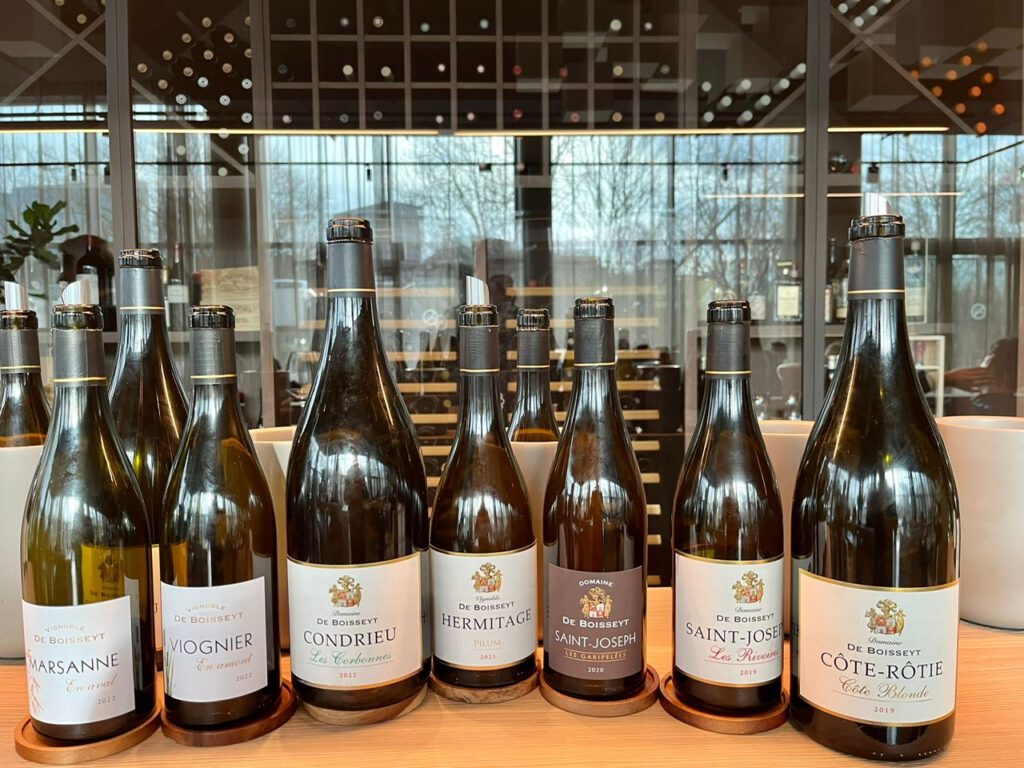
Granite Greatness: The Hermitage
Our last stop is Hermitage. The world-famous Hermitage hill is formed by a granite block, separated from the Massif Central. The 136 hectares of vineyards are separated in several climates, each expressing differences in terms of soil, microclimate and exposition. Historically Hermitage wines are built up on grapes from various climates. Nowadays however an increased number of producers bring out single vineyard Hermitages. About 75% of the Hermitage wines is red. They must be made from Syrah, with an optional addition of maximum 15% Marsanne and/or Roussanne. The white Hermitage wines are made from Marsanne and/or Roussanne.
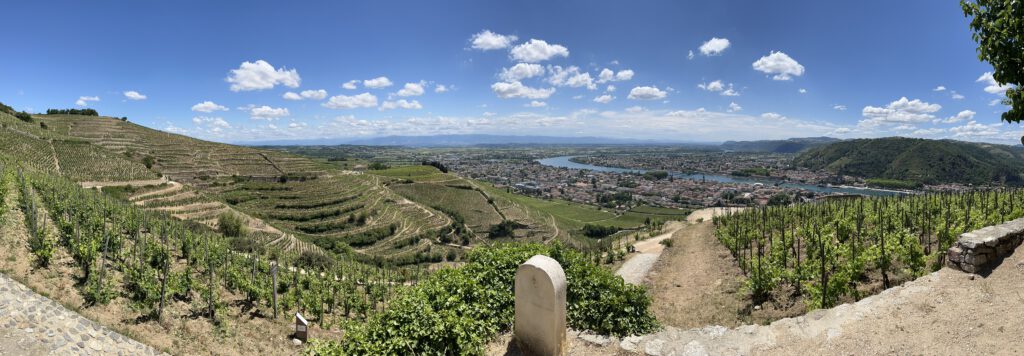
Domaine De Boisseyt – Hermitage Pilum 2021
100% Marsanne grapes from a granite soil with alluvial pebble stones form the base for this white Hermitage. The handpicked grapes are fermented in 400 litre barrels and aged for about 6 months, partly in barrels and partly in concrete vessels. According to Romain Decelle white Hermitage needs time – and we see why. The wine is very timid and opens slowly. We note citrus, green herbs and a touch of cream. The wine feels young and compact. In this stage the wine excels in power and linear length, but its true potential surely will appear with time.
We award this wine with a 93-point DWA score, remaking the wine is expected to excel with time.
Résidence Wijnen & Restaurant Showw
The wines of Domaine De Boisseyt are imported by Résidence Wijnen. We thank them to facilitate this virtual Northern Rhône trip. Résidence is a leading Dutch wine importer, focusing on quality above quantity. In the portfolio of Résidence we find strong identity producers out of almost every relevant wine growing area. Most producers are organic or biodynamic certified. Résidence also runs the franchise formula called ‘De Gouden Ton’.
Interesting detail: almost all of the wines were served out of glasses designed by Résidence itself, called the Verretti Univerre glass. The glass is designed to serve a wide range of wines and all the wines showed themselves perfectly in it.
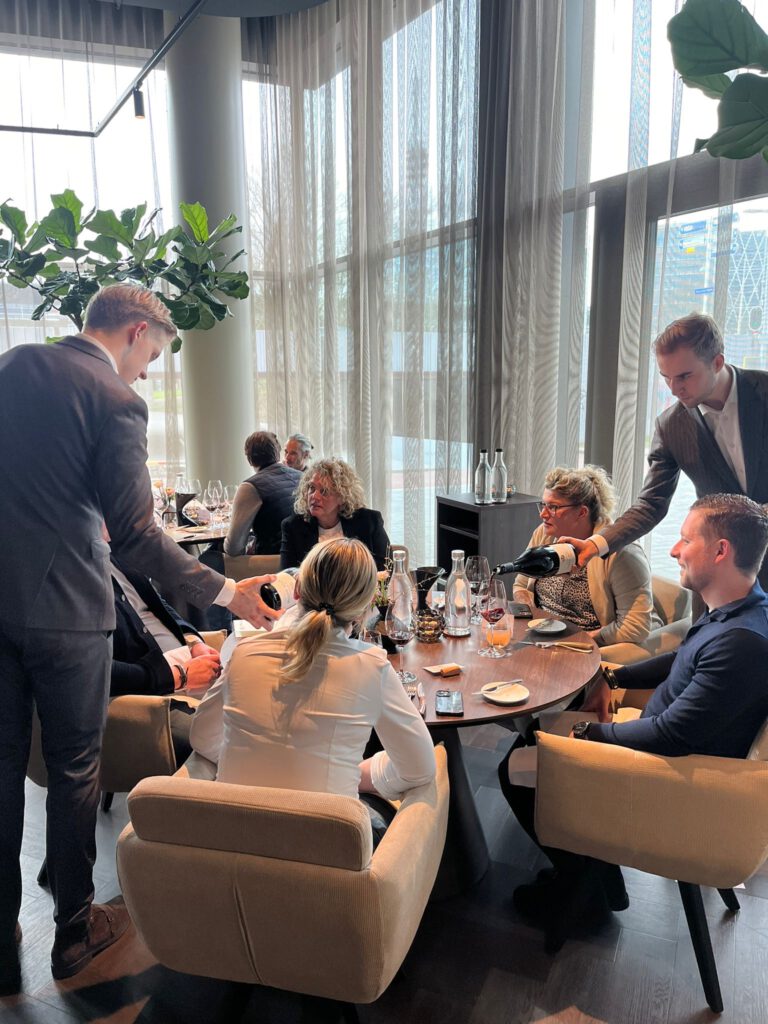
The wines were adorned by the wonderful dishes of Restaurant Showw. Top sommelier Lendl Mijnhijmer supervised the pairings and could not have done any better. The dishes were marked by a high flavour intensity and deep and complex sauces. The observant reader sees the parallel to the wines of Domaine De Boisseyt.
This article was written by our own Hermen Jansen. Domaine De Boisseyt is imported by Résidence Wijnen and available through De Gouden Ton. Picture credits: Dutch Wine Apprentice and Residence Wijnen.

